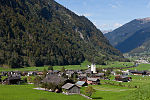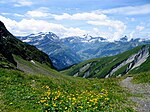Sernftal
AareLandforms of the canton of GlarusValleys of SwitzerlandValleys of the Alps

The Sernftal or Kleintal is an alpine valley within Glarus Süd, in the canton of Glarus, Switzerland. It is formed by the Sernf, a right tributary of the Linth. Situated in the Sernftal are the villages of Elm (977 m) and Engi (812 m). The Panix Pass at 2407 m connects the Sernftal with the anterior Rhine valley in Grisons.
Excerpt from the Wikipedia article Sernftal (License: CC BY-SA 3.0, Authors, Images).Sernftal
Tschogglen, Glarus Süd
Geographical coordinates (GPS) Address Nearby Places Show on map
Geographical coordinates (GPS)
| Latitude | Longitude |
|---|---|
| N 46.961 ° | E 9.171 ° |
Address
Tschogglen 8
8766 Glarus Süd
Glarus, Switzerland
Open on Google Maps







